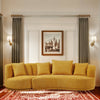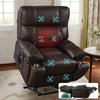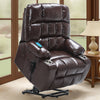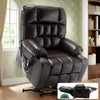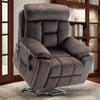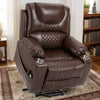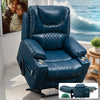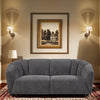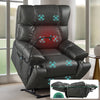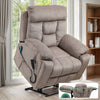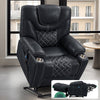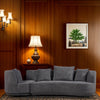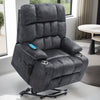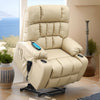Understanding the Role of Recliners in Geriatric Care
The Evolution of Recliner Design for the Elderly
Recliners have come a long way in meeting the needs of elderly users. Early designs focused on basic comfort. Now, they cater to specific health concerns. Modern recliners, especially lift recliners, offer enhanced support and ease of use. They feature adjustable positions, improved cushioning, and easy-to-use controls. These changes make recliners more suitable for seniors with limited mobility. The evolution reflects a growing awareness of the unique needs of older adults. It shows a commitment to improving their quality of life through thoughtful design.

Ergonomic Advancements in Recliners
Ergonomics plays a crucial role in recliner design for the elderly. Manufacturers now focus on creating chairs that support proper posture. They use materials that reduce pressure points and prevent bedsores. Many recliners now have adjustable lumbar support and headrests. These features help maintain spine alignment and reduce neck strain. Some models even offer heat and massage functions. These additions can help alleviate pain and improve circulation. The goal is to create a comfortable, supportive environment that promotes better health outcomes for seniors.
Impact of Recliners on Elderly Mobility
Recliners, particularly lift recliners, have a significant impact on elderly mobility. They assist in the sit-to-stand motion, reducing strain on joints and muscles. This feature is crucial for seniors with arthritis or weakened leg strength. By providing a stable base, recliners help prevent falls during transitions. They also encourage users to change positions regularly, which is vital for circulation. Some studies suggest that proper use of recliners can lead to improved overall mobility. By making movement easier, these chairs can help seniors maintain their independence longer.
Evaluating the Benefits of Recliners for the Elderly Population
Improved Comfort and Reduced Fatigue
Recliners offer significant comfort benefits for the elderly. They provide a supportive seating option that can be adjusted to individual needs. This customization helps reduce pressure on joints and muscles, leading to less fatigue. Many seniors find relief from back pain and other discomforts when using a well-designed recliner. The ability to elevate legs can help reduce swelling and improve circulation. Lift recliners make it easier to sit down and stand up, reducing the risk of strain or injury. This increased comfort can lead to better rest and overall well-being for elderly users.

The Psychological Benefits of Recliners in Elderly Care
The impact of recliners on elderly mental health is often overlooked. These chairs can provide a sense of security and independence. For seniors who struggle with mobility, a recliner can be a source of comfort and control. The ability to adjust their position easily can boost confidence and reduce anxiety. Recliners can also improve sleep quality, which is crucial for mental well-being. Some seniors find that recliners help them engage more in daily activities. This increased engagement can lead to better mood and cognitive function. Overall, recliners contribute to a more positive living experience for many elderly individuals.
Enhancing Independence with Recliner Aids
Recliners, especially lift models, play a key role in promoting independence among the elderly. These chairs help seniors maintain their ability to sit and stand without assistance. This independence can significantly improve their quality of life and self-esteem. Many recliners come with additional features that further enhance autonomy. These may include:
- Built-in trays for meals or activities
- Side pockets for storing essentials
- Remote controls for easy adjustment
- USB ports for charging devices
These features allow seniors to manage more tasks on their own. They reduce the need for constant caregiver assistance. This increased independence can lead to better mental health and a stronger sense of dignity for elderly users.
Implementing Recliners in Healthcare Settings and Beyond
Best Practices for Healthcare Organizations
Healthcare organizations can benefit greatly from implementing recliners in their facilities. To maximize these benefits, they should follow some best practices:

- Choose recliners that meet specific patient needs
- Ensure proper training for staff on recliner use and maintenance
- Regularly assess and update recliner inventory
- Create guidelines for recliner use in different care settings
- Incorporate recliners into patient care plans when appropriate
It's important to select recliners that are easy to clean and maintain. This helps prevent the spread of infections. Organizations should also consider the space requirements and mobility of the recliners. Proper implementation can lead to improved patient outcomes and staff efficiency.
Collaborations with Recliner Manufacturers
Partnerships between healthcare providers and recliner manufacturers can drive innovation. These collaborations can lead to designs that better meet the needs of elderly patients. Healthcare professionals can offer valuable insights into patient requirements. Manufacturers can use this feedback to improve their products. Some areas of focus for these partnerships might include:
- Developing recliners with advanced pressure relief systems
- Creating models with integrated health monitoring features
- Designing recliners that are easier for staff to operate and clean
These collaborations can result in recliners that not only enhance comfort but also contribute to better health outcomes. They can also lead to more cost-effective solutions for healthcare facilities.
Long-Term Outcomes and Cost-Effectiveness of Recliners
Investing in quality recliners can lead to positive long-term outcomes for elderly care. Studies have shown that proper seating can reduce the risk of pressure ulcers and falls. This can lead to fewer complications and shorter hospital stays. While the initial cost of specialized recliners may be higher, they can be cost-effective in the long run. They can reduce the need for additional medical interventions and staff assistance. Some healthcare facilities have reported:
- Decreased medication use for pain management
- Reduced instances of patient falls
- Improved patient satisfaction scores
These outcomes not only benefit patients but also contribute to the overall efficiency of healthcare facilities. As the population ages, the investment in proper seating solutions like recliners becomes increasingly important. It's a key factor in providing quality care while managing healthcare costs effectively.







